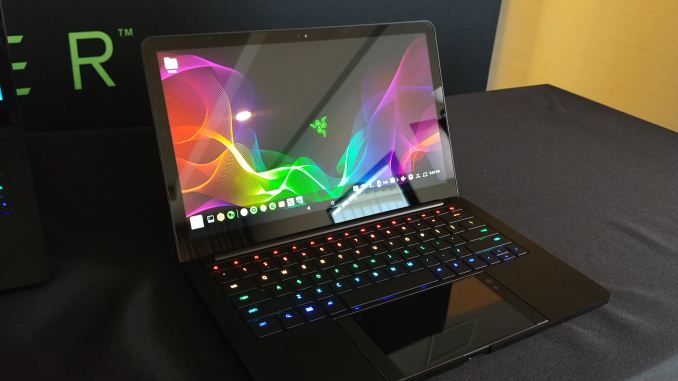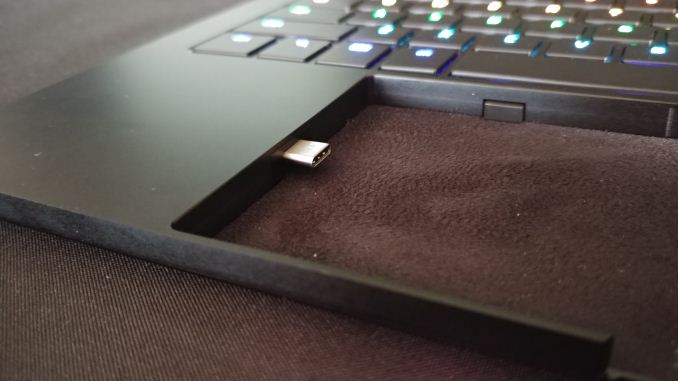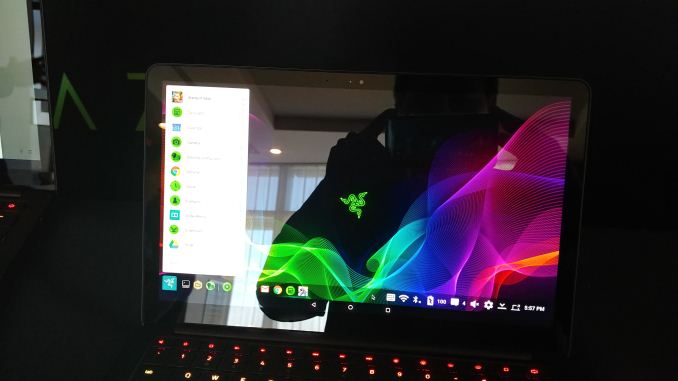Razer at CES 2018: Project Linda, Two Minutes Hands-On
by Ian Cutress on January 22, 2018 2:00 PM EST
At the start of CES, Razer announced Project Linda: a clamshell accessory for the Razer Phone that turns the smartphone into an Android-based laptop. The idea is that the phone is inserted into where the mousepad is, with the smartphone screen being used as the mousepad, the CPU, the GPU, and what the clamshell provides is a keyboard, USB and other ports, and a touch display similar in resolution to the smartphone, and some extra storage/battery, but at 13-inches. Some of the key features of the smartphone, such as the front-facing speakers, are used for audio. Ultimately this is meant to be for gamers that want to play Android games on a bigger screen with a mouse and keyboard, but still have something on the go that is better than a standard phone for standard workday things.
At the Razer suite, there were a couple of prototypes in action. Despite the software being nearly there, the hardware, for the most part, was done and fully working. The keyboard is RGB backlit, using chiclet-style keys, and the display (while not 120 Hz) was very bright. With the phone installed, it weighed about the same as my 13-inch laptop, though it was noticeable that all the weight was in the smartphone. Without the smartphone installed, it was very light.
One key feature I spent some time looking at was the mounting mechanism for the smartphone. Razer had lined the docking bay with a felt so as not to scratch the smartphone when it is inside, and in order to enable the USB Type-C connection, there is a button on the keyboard that forces a motor to protrude a USB Type-C connector. This is best displayed in a video:
To be honest, the noise of the motor was good. However, there were a few concerns. With the shape of the Razer phone, it could obviously be put in four different ways: the right way, the right-way-up but the wrong way around, the wrong way up and the right way around, or just the wrong way altogether. Because the motor that pushes the connector is based on the keyboard and not from the smartphone, there would be no way to save either device if the smartphone was put in incorrectly. Arguably if the phone was just upside down, the USB-C would still go in, but the user would not have a touch-pad, but the wrong way around would certainly break *something*. When discussing with engineers, there was no obvious solution to avoid users accidentally doing this, and the advice was ‘don’t’.
There are still a number of bugs to sort out on the software, but Razer expects Project Linda to be ready to go, perhaps in Q2. While it won’t be applicable for my user workload, and Razer ultimately targeting a small market (i.e. Razer Phone owners only) that also have the need for an Android laptop/gaming device, Razer is fully confident about enhancing its ecosystem. Unconfirmed rumors around Razer’s next mobile device point to a Q3 launch, with perhaps Linda focusing on that as a primary attachment device. We were unable to confirm these rumors.



















21 Comments
View All Comments
Diji1 - Monday, January 22, 2018 - link
Having owned an Nvidia Shield I can tell you that Android gaming is a sewage tank with the occasional gem. Very occasional. And that was including Nvidia's Shield only games.If you are a gamer you would be far better served with a Nintendo Switch and a phone. iOS also has a bunch of quality games that are not on Android, presumably because Android users don't buy stuff on their phones.
myrmidon - Tuesday, January 23, 2018 - link
I can see this as dual-use.It's great for the work-from-home crowd, as Android supports a huge amount of VPN's and remote desktop software that is great on a tablet, but painful on a phone. A 13" touchscreen 'dock' would give you the best of both worlds instantly.
On the gaming side, this would be *amazing* for RetroArch. I primarily play emulated games on my phone and would love to have a bigger screen + more than one USB port.
abrowne1993 - Monday, January 22, 2018 - link
NFC seems like a simple way to make sure the phone is oriented correctly, provided it's not located right in the center of the phone.abrowne1993 - Monday, January 22, 2018 - link
Or RFID I guess would be better.Tigersam - Monday, January 22, 2018 - link
Hmm..... imho, it doesnt make alot of sense. One of the main thing about phone is mobility. I can play game with my phone anywhere. The only additional accessory is perhap just a powerbank in case i ran out of power.Now, with this new gadget. I have to lug a notebook (same size) around, the only thing i get is a bigger screen and a keyboard.....
Btw, we all know how crappy touch pad is for gaming so we probably still need a mouse.
In the end, mobility is no longer there. If you need to put it on your lap or table to use, how is it different from a laptop or tablet? Its just an android verson of surface pro.
PeachNCream - Tuesday, January 23, 2018 - link
It might be arguable that having your games and saved progress on a single device is a selling point. Carrying around a totally independent, secondary device in the form of a laptop or tablet might imply spending time to sync up or simply not share that saved progress. Then again, PC games are probably a lot better suited to keyboard and mouse or keyboard and touchpad play since they were designed with those interface devices in mind from the start too.I still don't quite get where Project Linda fits into the mobile equation from a mobile gaming perspective or totally understand the logic behind why Razer is making gaming a target usage case over the much more obvious productivity benefits that something like Linda would offer.
Tigersam - Monday, January 22, 2018 - link
Imho, razor could think about those flexible oled screens for both keyboard and screen. Imagine roll it out of your phone or attach it for a bigger screen. Then a small led to project keyboard and mouse onto a surface. It detect your fingers movements (the led virtual keyboard came out ages ago but died). Its hard to type.But i think it will be really cool and looks like something in sci fi movies
Tams80 - Friday, January 26, 2018 - link
There are laser keyboards already out there. They aren't popular because they just aren't very good. Typing on a hard surface with no give what-so-ever begins to hurt quickly.Sure, you can use some soft surfaces, but they tend to be uneven, which badly messes with key registration. Plus you then need to carry around or find such surface anyway.
piroroadkill - Tuesday, January 23, 2018 - link
Woah, we're back in 2011 again. It's a Motorola Lapdock. Or maybe 2012, with the Asus Padfone. We've had phones that could run desktop environments on large screens for a while, spearheaded by Motorola really, with the Atrix being the first I recall, but it turns out people didn't really want them, and still don't.Valantar - Tuesday, January 23, 2018 - link
Wouldn't it be rather trivial to have the motor cut off/reverse if it encounters resistance beyond a certain threshold of force? I mean, CD and DVD players of the late 90s did this. Can't be that hard, and they certainly didn't have additional sensors to check for obstructions. This probably wouldn't avoid the connector nicking the paint of the phone, but that's the price you pay for not knowing how to use your own equipment. If they implement that, the only other thing necessary IMO is a sticker saying something like "place phone USB connector here" inside the cradle.